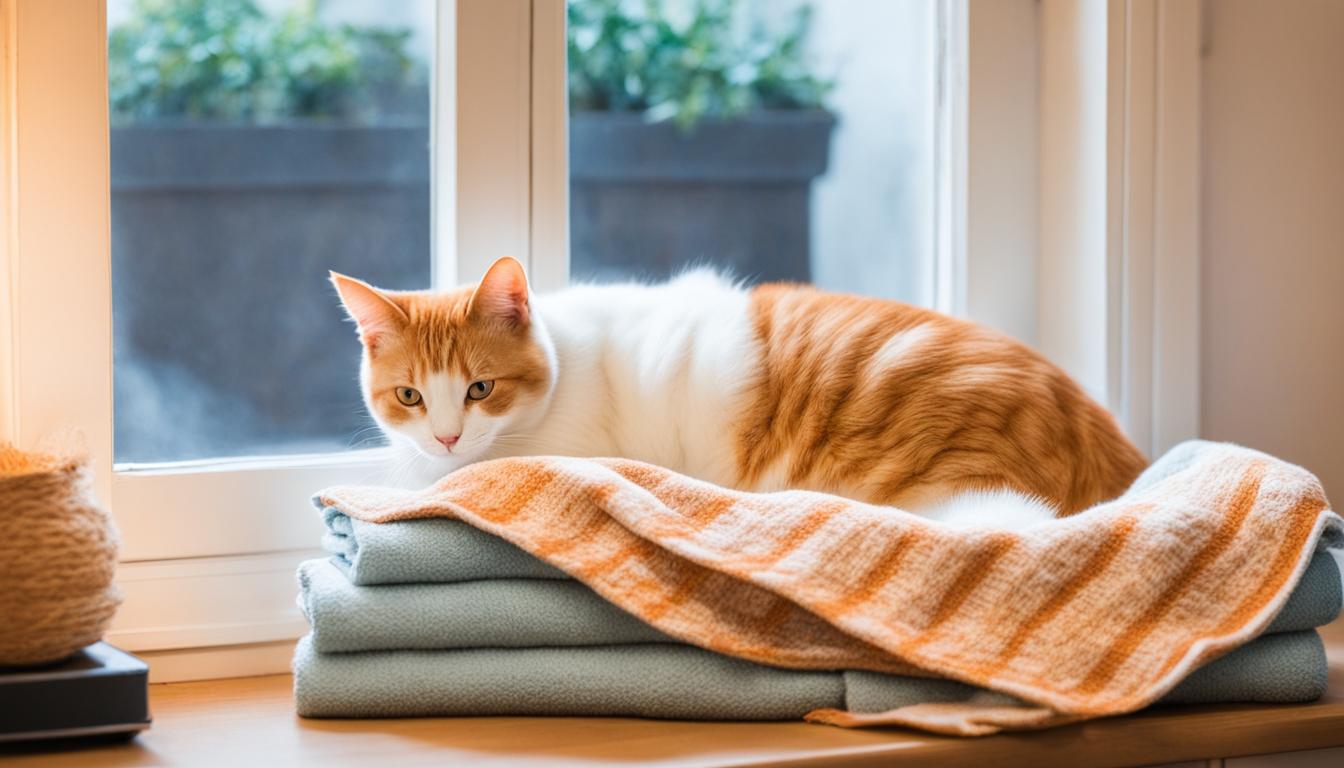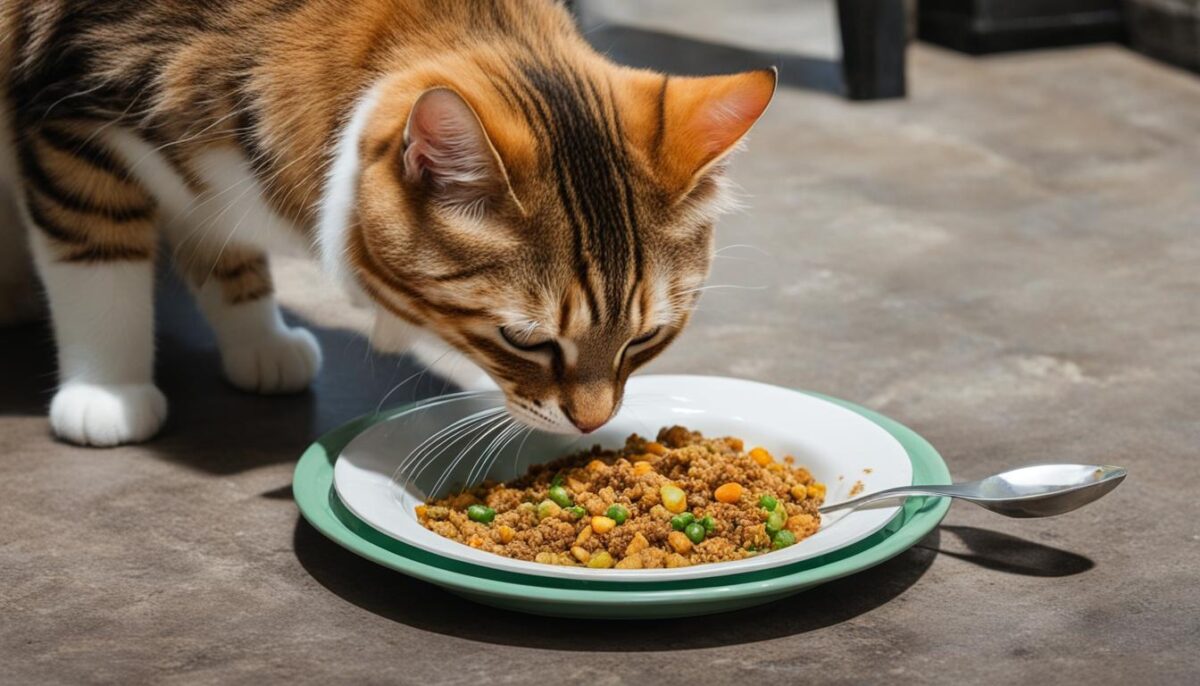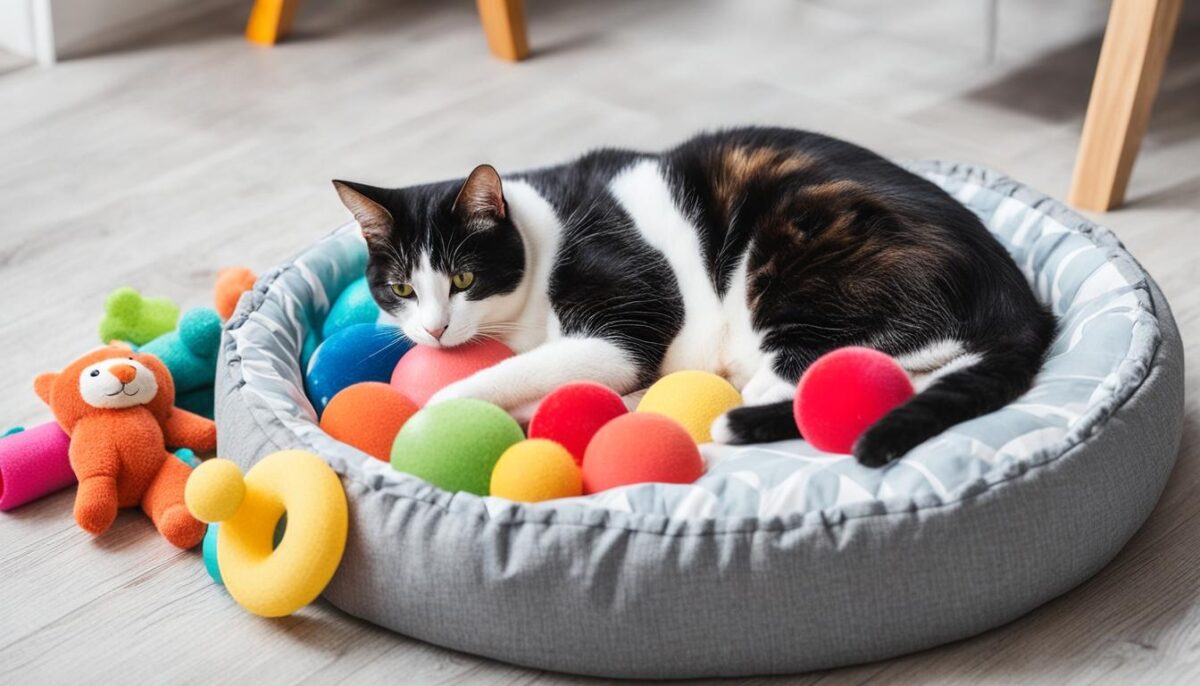Have you noticed your furry friend acting a bit unusual? If you’re wondering about those changes, she just might be an expecting cat. You see, when a cat is going to have kittens, she shows some special signs. Let’s learn together about pregnant cat signs and cat pregnancy behavior. During feline gestation, your little queen will get a big belly and want a lot of love. She also starts to find a cozy spot for her babies, which are called kittening signs.
Key Takeaways
- Pregnant cat signs are clues that your cat might be having kittens soon.
- As part of cat pregnancy behavior, she might cuddle with you more or talk a lot.
- During feline gestation, your cat’s tummy gets bigger as the kittens grow.
- An expecting cat looks for a warm, safe place to welcome her kittens.
- Watch for kittening signs to know when the kittens might arrive.
Identifying the Signs of Cat Pregnancy
Is your furry friend expecting little ones? Let’s look for some early signs to be sure! Your queen cat’s pregnancy is a delightful time, so it helps to know what to expect.
When You Might Notice ‘Pinking-Up’
About two or three weeks after a cat meets a mate, her nipples may get bigger and turn a pinkish color. This is because she’s getting ready for her babies, and it’s one of the first signs you might see.
Gentle Behavior Changes and Weight Gain
Your cat might act a little different, too. She can be cuddly one minute and a bit grumpy the next. It’s okay—she’s just adjusting to the new life growing inside her. Plus, her body will grow bigger as the kittens do. She could gain between one and two kilograms. Imagine carrying all that extra weight!
Pre-Labor Activity and Nesting Instincts
As the big day approaches, your cat will look for a peaceful spot to have her kittens. She’ll settle down and begin to make this place cozy, which is a behavior called nesting. It’s much like when you build a fort to play in! Keep an eye on her, as you might notice she’s not as active, and she’s getting ready for cat labor signs which include a drop in her body temperature, feeling restless or even tossing her cookies!
Want to keep track of these changes? Check out the table below to help you spot these signs as your cat gets ready for her new family.
| Sign | Description | When to Expect |
|---|---|---|
| Pinking-Up | Nipples enlarge and change color | 2-3 weeks after conception |
| Behavior Change | Affectionate or moody | Throughout pregnancy |
| Weight Gain | Queen may gain 1-2 kg | Gradually during pregnancy |
| Nesting | Searching for a quiet, safe spot for delivery | Just before labor starts |
| Labor Signs | Drop in body temperature, restlessness | 24-48 hours before delivery |
By looking out for these early signs of cat pregnancy, you’ll have a good idea of when your queen cat is getting ready to bring new life into your home. Isn’t mother nature amazing?
Feeding Your Expectant Queen
When your cat is expecting, her eating habits need to change. Think of it like this: she’s not just eating for one anymore! The little kittens growing inside her need lots of good stuff to help them grow strong. That means your cat needs extra yummy and healthy food as part of her cat pregnancy diet.
Adjusting Your Cat’s Diet for Pregnancy
Starting with her diet, you’ll want to give her more food than usual. She may need up to one and a half times the amount she ate before she was pregnant. By the end of her pregnancy, she might even need twice as much! This helps make sure she’s got enough energy for herself and her future kittens. And guess what? Feeding your pregnant cat the right food is a big part of how you take care of her during this special time.
The Importance of Nutrient-Rich Foods
It’s not just about more food; it’s about the right kind of food, too. The best meals for your cat now are those packed with nutrients. Foods made for pregnant kitties or baby kittens are perfect because they’re full of what she needs. Foods like this help your expectant queen stay healthy and have the energy she needs.
Remember, taking care of a pregnant cat is a big job, but you’re not alone. Your vet can help you pick the best food for her. So don’t be shy about asking for some advice on the proper nutrition for an expectant queen. Your furry friend deserves it!
And here is what a proper diet for your pregnant cat could look like:
| Weeks of Pregnancy | Daily Food Intake | Notes |
|---|---|---|
| 1-3 | Normal Amount | Regular adult cat food |
| 4-6 | 1.5x Normal Amount | Switch to kitten/pregnant formula |
| 7-9 | Up to 2x Normal Amount | High in protein and nutrients |
Pregnant Cat Behavior Before Birth
When your cat is pregnant, you may see changes in what she does. This is her feline prenatal behavior. A few weeks before she has her kittens, your cat will look for a safe spot. This is one of her maternal cat instincts. She will want to find a warm and cozy place for her little ones.
Your cat may also start to act more like a mom. She might purr more and like quiet places to rest. Her tummy will get bigger as the babies grow, and her milk-making parts, called mammary glands, will also get bigger. Sometimes, she may not eat as much. This is all part of pregnant cat care.
It’s good to watch these signs. They tell you your cat’s babies will come soon. This way, you can make sure she feels safe and loved.
| Before Birth Sign | What It Means | How You Can Help |
|---|---|---|
| Looking for a Safe Place | Your cat is preparing for delivery. | Make a cozy spot with blankets and keep it quiet. |
| Purring and Seeking Quiet | She’s feeling motherly and wants peace. | Give her gentle pets and a calm home. |
| Not Eating Much | She’s getting ready to have her kittens. | Be patient and leave food out, she may eat later. |
Preparing for the Arrival of Newborn Kittens
So, your cat is about to have kittens. Exciting times are ahead! When it comes to kitten birth preparation, your job is to make everything comfy and safe. A special spot called a “birthing box” is where the magic happens. It’s a place where your cat can feel secure when her little ones come into the world. Let’s talk about how to set it up!
Setting Up the Kittening Bed
Think of making a nice, warm bed for the kittens. You will need a box big enough for your cat and her babies. Line it with soft towels or blankets to keep it warm and cozy. This is what people mean by setting up a birthing box. Place the box in a quiet spot where there’s not a lot of noise or people walking around. This way, your cat can have her kittens without any stress.
Understanding Your Role During Cat Labor
When the big day comes, your cat does most of the work, but sometimes she might need your help. Assisting cat labor means being there in case of any trouble. Keep an eye on things, but remember, it’s best to let momma cat do her thing. She knows just what to do. If something doesn’t seem right, that’s when you might need to step in or call the vet. But once the kittens are born, all you’ll need to do is change the dirty towels for clean ones. Now, you’re all set to welcome those tiny paws into the world!
Recognizing the Stages of Cat Labor and Delivery
If you have a cat that is going to have kittens, it’s a good thing to learn about the feline delivery stages. Knowing what to expect can help you to help your cat when she has her babies. Let’s talk about what will happen when your cat is ready to give birth.
What Happens During First Stage Labor
When a cat gets ready to have her kittens, she starts the first stage of labor. You might notice signs of cat labor like the queen being restless or maybe even a clear discharge. This stage can take some time, but this is normal, so don’t worry!
Anticipating Second and Third Stage Labor
The next part is when the kittens start to come out. Your cat will have stronger contractions and push a lot. This is called the second stage. Right after each kitten comes out, the third stage happens, and that’s when the afterbirth comes out. It’s okay to be there for your cat, but remember that most cats can do this part on their own. They are natural at aiding kitten birth.
But, if you see that your cat is trying too hard and no kitten comes out for a long time, you need to call the vet. The vet knows how to help cats that have problems when they have babies.
Remember, giving your cat a quiet place and being there for her can make the birthing easier. And now that you know about the stages of cat labor, you can help make sure everything goes smooth for your cat and her new little kittens!
Conclusion
Your pregnant cat has been through a lot, and now that her kittens are here, she still needs your help. You’ve already learned so much about taking care of her during this special time. It’s important to keep watching her and the little ones closely, making sure they’re all happy and healthy. Keep their space warm and cozy, and make sure it’s always clean too. The safety and comfort of your cat and her babies matter a lot.
Supporting Your Cat Through a Healthy Birthing Process
Postnatal cat care starts with giving your cat a quiet place to care for her kittens. You should check on them often, but try not to disturb the new family too much. Keep an eye on how the kittens are doing, and watch the momma cat for how she behaves after the birth. She’s strong, but she’s also just gone through a lot. She needs to know you’re there for her.
Knowing When to Seek Veterinary Assistance
If you think something is not right with the mom cat or her babies, it’s okay to ask for help. Sometimes, mom cats need a vet after having kittens. Vets can offer good advice and help if there’s any trouble. Remember to get them all checked by the vet soon after the kittens are born. They can make sure everyone is healthy and doing well. If you ever have questions or worries about your cat and her new kittens, the vet is always there to help you.
FAQ
How can you tell if a cat is pregnant?
You may observe some early signs such as ‘pinking-up’ of the nipples, affectionate behavior changes, weight gain, and a swollen belly, indicating that your cat is expecting kittens.
What behavior changes might indicate that a cat is nearing labor?
As labor approaches, a cat may display increased nesting behavior, seek out quiet and safe places, show restlessness, experience a drop in body temperature, and may even refuse food.
How should you adjust your cat’s diet during pregnancy?
You should provide your pregnant queen with increased nutrition, offering up to one and a half times her regular intake, and later, even more. A diet rich in nutrients formulated for pregnant or growing cats will help her support her litter’s growth.
What kind of environment does a pregnant cat need as she prepares to give birth?
A quiet, secure, and comfortable area is best for a pregnant cat preparing to birth. A birthing box in a calm part of your home will help her feel safe to deliver her kittens.
What are the stages of cat labor, and how can you support your cat through them?
Cat labor has three stages—cervical relaxation and initial contractions, active delivery of kittens, and expulsion of the placenta. Support your cat by providing a tranquil environment and seeking veterinary assistance if there are signs of distress or complications.
What postnatal care do the mother cat and her kittens need after birth?
Postnatal care includes ensuring the birth area is clean, monitoring the health and behavior of the mother and kittens, and providing vet check-ups to keep them all healthy.
How can you recognize that a cat is preparing a nesting spot?
A nesting cat will look for secluded, comfortable places to deliver her kittens. She may arrange towels, blankets, or other soft materials in a specific area, indicating her preparation for labor.
When should you be concerned during a cat’s labor?
You should be concerned if labor persists for an extended period without the birth of a kitten, or if the mother cat appears in distress, with symptoms such as prolonged straining or exhaustion. In any of these cases, contact a veterinarian immediately.
How long does the ‘pinking-up’ phase last in a pregnant cat?
The ‘pinking-up’ phase generally appears about two to three weeks after conception and is one of the first visible signs of cat pregnancy.
Are there any special considerations for feeding a pregnant cat?
Yes, pregnant cats require foods that are high in protein and other nutrients. Foods that are formulated for kittens or are labeled for pregnant and lactating queens are good choices to meet the higher energy requirements.
Source Links
- https://www.medicanimal.com/Understanding-the-signs-and-stages-of-pregnancy-and-advice-on-caring-for-your-pregnant-queen/a/ART111488
- https://www.dailypaws.com/cats-kittens/health-care/cat-neutering-spaying/how-to-tell-when-a-cat-is-ready-to-give-birth
- https://vcahospitals.com/know-your-pet/pregnancy-and-parturition-in-cats


